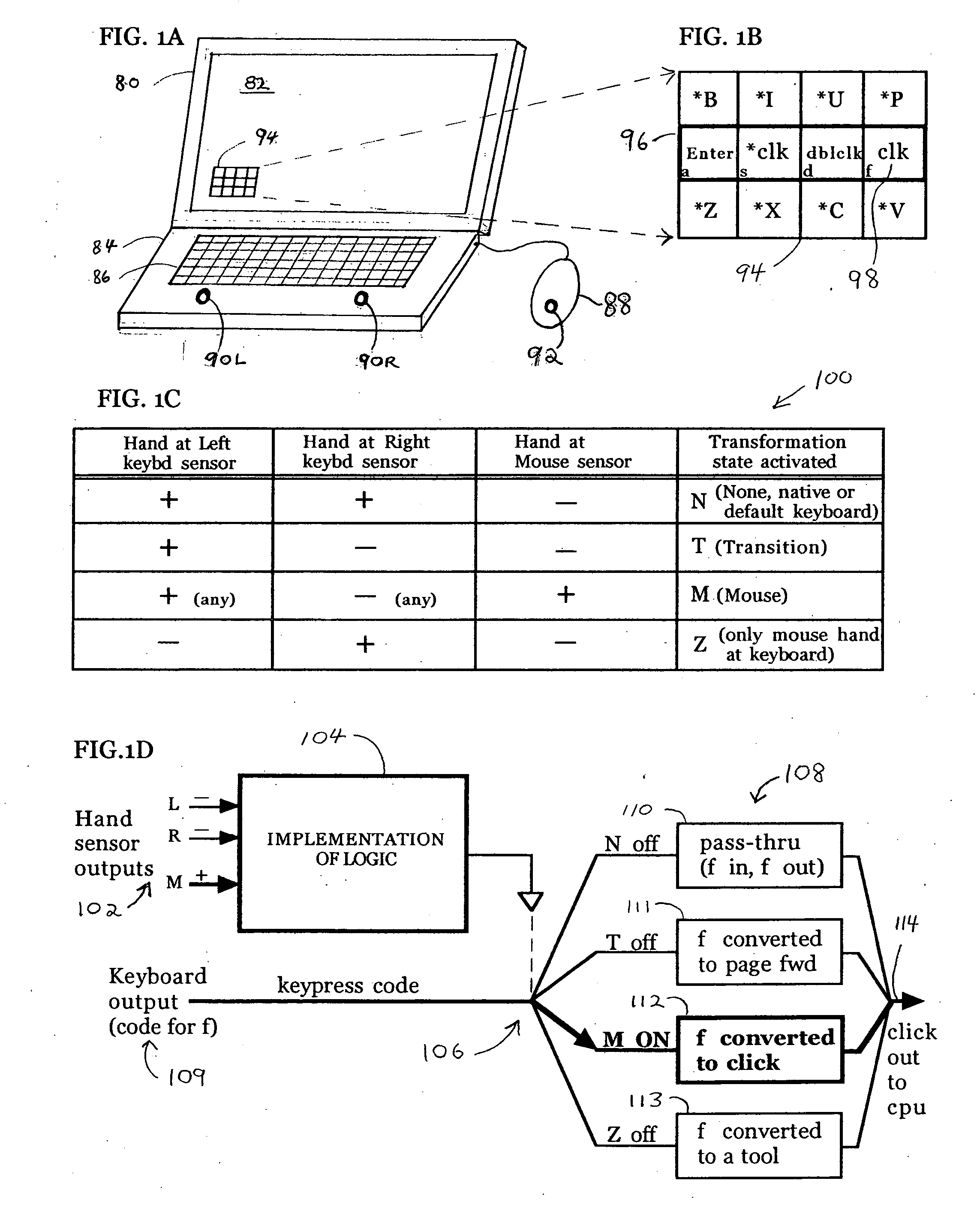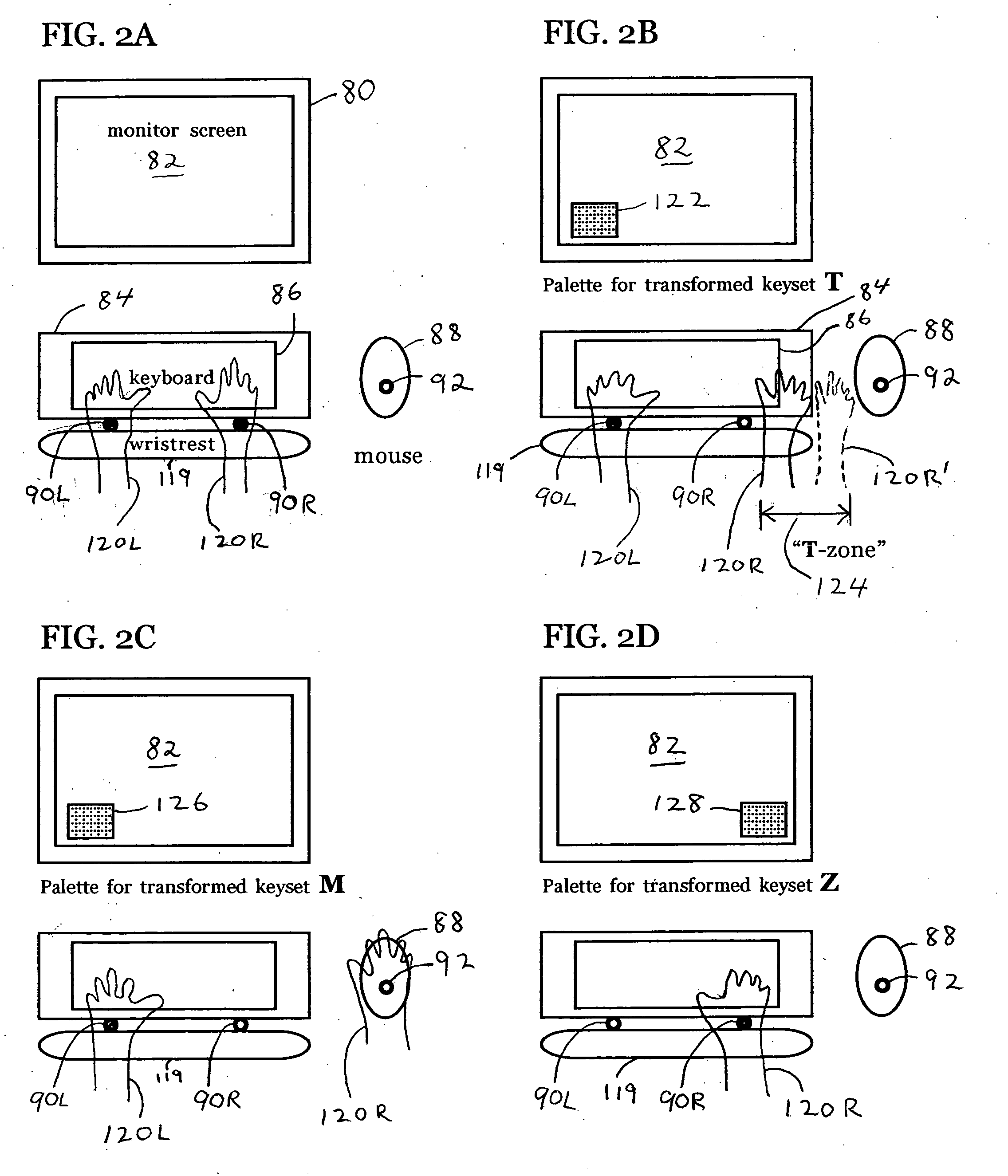Method and apparatus for automatically transforming functions of computer keyboard keys and pointing devices by detection of hand location
a technology of automatic transformation and computer keyboard, applied in the field of computers, can solve the problems of stress, shoulder, wrist and hand problems, and already strain, and achieve the effects of reducing the need for mousing down menus, reducing stress on the mouse hand, and facilitating tool selection
- Summary
- Abstract
- Description
- Claims
- Application Information
AI Technical Summary
Benefits of technology
Problems solved by technology
Method used
Image
Examples
embodiment 1
[0303]FIG. 48: is a junction box embodiment with firmware detection of hand location (no external sensor), and with a choice of preprogrammed transformed keysets. Refer to FIGS. 25A, B and C and their description for an introduction to the non-sensor hand location detection of this invention. “TPI” (1280) stands for any standard Transfer Protocol Interface, such as USB. Mouse detector 1264 latches M on when it detects an output from the mouse. Switch 1262 enables transformed keyset M when hand first moves or clicks pointing device 88 (via TPI 1263, and detector 1264 which also illuminates transformation indicator Led 1265), and becomes disabled upon detection of the next output from the mouse hand side of the keyboard via TPI 1276 and keyboard detector 1266. Detector 1266 detects the output from the mouse hand side of the keyboard, which causes it to latch M off. Key code output 1270 of “any external keyboard”84 is fed into junction box 274 and then through input TPI 1276, and when ...
embodiment 2
[0305]FIG. 49 is a junction box embodiment with discrete proximity sensor at mouse and programmable firmware. Switch 1308 enables transformed keyset M whenever a hand is at the pointing device (as in truth table of FIG. 9A). Hand presence at pointing device 88 is detected by discrete hand proximity sensor 92 which outputs a presence signal to microprocessor inside pointing device 88 which encodes presence signal and sends it as a code into junction box 1304 and then via input TPI 1263 to sensor presence signal code detector 1306. When detector 1306 detects hand presence signal coming from pointing device sensor it causes switch 1308 to route all signals from keyboard into “programmable code transformation list M (look-up table)”1310. It simultaneously activates transformation indicator(s) Led 1265 and / or optional sound generator 1311. Key code output 1270 of “any external keyboard”82 is fed into junction box 1304 and then through input TPI 1276 and, with switch 1308 in the transform...
embodiment 3
[0306]FIG. 50A is a junction box embodiment with L and R sensors added below a standard keyboard, with preprogrammed transformed keysets, and reprogrammable firmware. Transformed keyset M (1342) is enabled by switch 1320 when mouse hand departs keyboard typing position, and becomes disabled upon its return to typing position. Optional transformed keyset Z is enabled by switch 1320 when non-mouse hand departs typing position. Photosensors 90L and 90R for detecting presence of hands at left and right sides of keyboard 84 are mounted, together with extra thumb keys 132, 134L and 134R for ST, ORT, etc., in retrofit carrier strip 1322 (similar to 130 of FIGS. 3 and 5, or to wrist rest 140 or 144 of FIG. 4) or box below or attached to the keyboard. Photosensor signals are conditioned 1324 and processed by sensor logic 1326 as shown in FIGS. 9D (logic truth table), 10B and 13D and in their discussion, and are balanced by means shown in FIG. 11A or FIG. 11B, with external “rebalance sensors...
PUM
 Login to View More
Login to View More Abstract
Description
Claims
Application Information
 Login to View More
Login to View More - R&D
- Intellectual Property
- Life Sciences
- Materials
- Tech Scout
- Unparalleled Data Quality
- Higher Quality Content
- 60% Fewer Hallucinations
Browse by: Latest US Patents, China's latest patents, Technical Efficacy Thesaurus, Application Domain, Technology Topic, Popular Technical Reports.
© 2025 PatSnap. All rights reserved.Legal|Privacy policy|Modern Slavery Act Transparency Statement|Sitemap|About US| Contact US: help@patsnap.com



